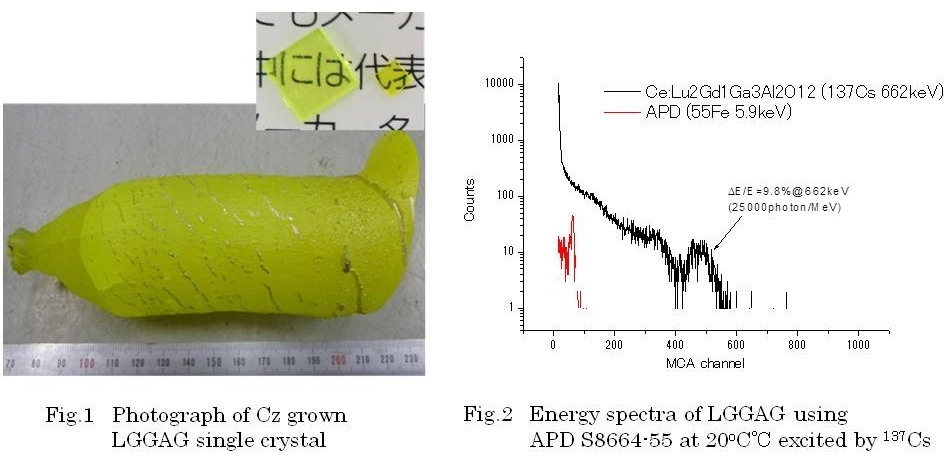| Search for content and authors |
Growth of Ce:doped Lu2Gd1Al2Ga3O12 single crystal by the Czhocralski method and their scintillation properties |
| Akira Yoshikawa 1,2, Kei Kamada 2, Yasuhiro Shoji 1, Shunsuke Kurosawa 1,2, Yuui Yokota 2, Petr Prusa 3, Martin Nikl 1,3 |
|
1. Institute for Materials Research, Tohoku University, 2-1-1, Katahira, Aoba-ku, Sendai 980-8577, Japan |
| Abstract |
Scintillator materials combined with photodetectors are used to detect high energy photons and particles in X-ray computed tomography (CT), positron emission tomography (PET) and other medical imaging techniques, high energy and nuclear physics detectors, etc. In the last two decades, great effort was made to develop more efficient and faster scintillators in order to detect ionizing radiation. This effort resulted in development of Ce-doped orthosilicates, namely the Gd2SiO5 (GSO), Lu2SiO5 (LSO), (Lu1−xYx)2SiO5 (LYSO), pyrosilicates based on RE2Si2O7 (RE=Lu, Y,Gd) and most recently LaX3 (X=Cl,Br) single crystal hosts. The best combination of stopping power, decay time, and light yield is currently achieved by Ce-activated materials. Nevertheless, there is still a continuous demand for new scintillator materials with even better properties. Oxide materials based on garnet structure are promising candidates for scintillator applications because of well mastered technology developed for laser hosts and other applications, optical transparency and easy doping by rare-earth elements. The Ce-doped Lu3Al5O12 (Ce:LuAG) single crystal showed to be a prospective scintillator material with relatively high density of 6.7 g/cm3, fast scintillation response of about 60–80 ns (due to the 5d1-4f radiative transition of Ce3+ providing the emission around 500–550 nm), and light yield of about 12–14,000 photon/MeV [1]. Recently, Ce:(LuyGd1-y)3(GaxAl1-x)5O12 scintillator grown by μ-PD method were investigated and Lu2Gd1Ga3Al2O12 showed light yield of about 21000photon/MeV decay time of 46ns and density of 7.13 g/cm3[2]. In this study, 1 and 2inch size Lu2Gd1Ga3Al2O12 (LGGAG) single crystals were grown by the Czhocralski (Cz) method using an RF heating system. The rotation rate was 4–10 rpm and the growth rate was 1.0 mm/h. An automatic diameter control system using crystal weighing was applied to control the growth parameters. Crystals were grown from a 100mm diameter Ir crucible under Ar with adding CO2 atmosphere to prevent evaporation of gallium oxide. The seed crystal was a [100] oriented LuAG crystal. The LGGAG crystals with a diameter of 50mm and length of 150 mm were grown. Powder X-ray diffraction and Electron Probe Micro Analyzer were performed to observe crystal phase and chemical composition of grown crystals. Scintillation properties such as light yield and decay time were also evaluated. The light yield of 2 inch size LGGAG was around 25,000photon/MeV. Effect of growth atmosphere, evaporation of gallium oxide and growth scale on scintillation properties will be discussed in the presentation.  [1] Nikl, M.; Mihokova, E.; Mares, J. A.; et al. Phys. Stat. Sol. 2000, B 181, R10-R12 [2] K. Kamada, T. Yanagida J. Pejchal, M. Nikl, T. Endo, K. Tsutumi, Y. Fujimoto, A. Fukabori and A. Yoshikawa, Crystal Growth and Design, 11 (2011) 4484–4490 [1] Nikl, M.; Mihokova, E.; Mares, J. A.; et al. Phys. Stat. Sol. 2000, B 181, R10-R12 [2] K. Kamada, T. Yanagida J. Pejchal, M. Nikl, T. Endo, K. Tsutumi, Y. Fujimoto, A. Fukabori and A. Yoshikawa, Crystal Growth and Design, 11 (2011) 4484–4490 |
| Legal notice |
|
| Related papers |
Presentation: Poster at 17th International Conference on Crystal Growth and Epitaxy - ICCGE-17, Topical Session 6, by Akira YoshikawaSee On-line Journal of 17th International Conference on Crystal Growth and Epitaxy - ICCGE-17 Submitted: 2013-04-15 08:32 Revised: 2013-07-30 09:49 |